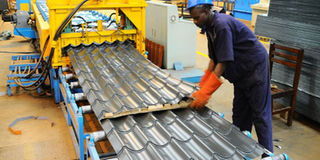Large firms no longer exporting to Rwanda

Difficult and expensive: Some exporters, among them producers of roofing material, have had to stop exports to Rwanda because it turned out to be difficult and expensive to access the market through alternative routes. FILE PHOTO
What you need to know:
- Difficulty in market access. The Large producers such as Roofings, Movit and Hima Cement, among others are no loner exporting to Rwanda citing difficulty in accessing the country’s market.
- According to Mr Mwesigwa, who is also a representative of Uganda at the East African Business Council (EABC), the closure of the Rwanda border continues to be a concern for the Council itself.
Large manufacturers, among them cement, steel and roofing material producers are no longer exporting to Rwanda pending outcome of talks between the government in Kigali and Uganda.
Roofings, Hima Cement and Movit are among the companies that have stopped exports to Rwanda, which closed its border with Uganda in February last year.
It is almost a year since the border point at Katuna was been closed. However, manufacturers that Daily Monitor spoke to say that although no one has stopped entry of their goods into Rwanda, it difficult and expensive to access the country through other alterative routes.
Mr Stuart Mwesigwa, the Roofings business development manager, at the weekend told Daily Monitor: “We stopped exports to Rwanda”, without giving details.
Roofings, which manufacturs iron sheets and other steel products, had a monthly shipment of between 600 and 1,000 tonnes of exports to Rwanda estimated at between $7m and $8m.
Other exporters such as producers of personal care products, petroleum products, beverages and consumer goods, are also nolonger sending exports to Rwanda.
Last week, Ms Caroline Kezaabu, the Hima Cement public relations officer, told Daily Monitor, they had “stopped exports to Rwanda because we don’t have access to this market”.
About 30 per cent of Hima’s export goods, she said, were going to Rwanda, noting that the company was now trying to maximise sales to DR Congo and South Sudan to cover for the lost Rwanda market.
“But these two markets [DR Congo and South Sudan] cannot be compared to what we were exporting to Rwanda,” she said.
In June 2018, for example, Hima Cement commissioned a $40m factory in Tororo that sought to increase its capacity to produce both for local and the export market.
The plant added about 0.8 million tonnes per annum to the Cement manufacturer’s capacity in addition to the 0.9 million tonnes that it had been producing at the Kasese plant.
According to Bank of Uganda, Uganda’s export earnings from Rwanda for the year ended November 2019 radically dropped to $41.9m (Shs155b) up from $212m (Shs784bn) in 2018.
The border impasse has seen Uganda’s exports decline by at least 405 per cent in only a year.
The report also notes that during the same period, Uganda’s import bill from Rwanda dropped by just 15 per cent. In the period, Uganda imported goods worth $15.7m (Shs58b) down from $18.1m (Shs66b).
Although Rwanda had left other border points such as Mirama Hill, Cyanika and Kamwezi, exporters Daily Monitor spoke to said it is difficult and expensive to use the routes.
Movit, manufacturers of personal care products, at the weekend also indicated they had stopped exports to Rwanda.
Mr John Tumwesigye, the Movit head of communications and events, said when Katuna was closed, “we stopped exports [because] the alternative routes we couldn’t use them”.
“We lost business,” he said, noting that they have now intensified marketing campaigns in other countries such as Zambia, DR Congo, Tanzania, Burundi and South Sudan to cover for the losses occasioned by Rwanda.
EACB appeal
According to Mr Mwesigwa, who is also a representative of Uganda at the East African Business Council (EABC), the closure of the Rwanda border continues to be a concern for the Council itself.
“We are concerned. We want regional trade to happen. We want markets to be open. This is the only way we can utilise our capacities and convince the international market that we capable of competing,” he says.




